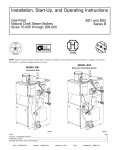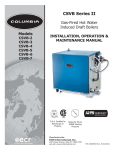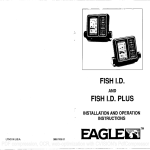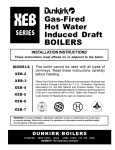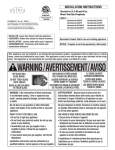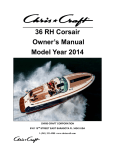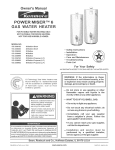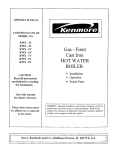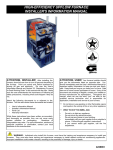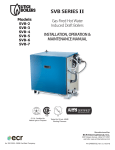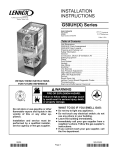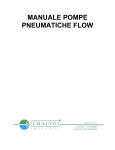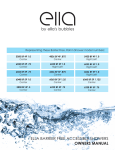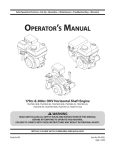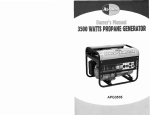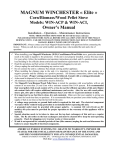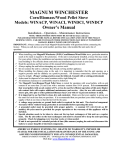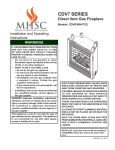Download Dunkirk XEB-4 Operating instructions
Transcript
XEB Series Gas-FiredHot Water Induced Draft Boilers INSTALLATION, OPERATION & MAINTENANCE MANUAL DUNKIRK 85 Middle BOILERS Rd. Dunkirk, NY 14048 www. dunkirk, corn P/N 14683001 Rev. B [11/09] Safety Symbols ........................................................................................................................................................ 2 Installation 3 Instructions ......................................................................................................................................... Boiler Ratings And Capacities ................................................................................................................................ 3 Before You Start ...................................................................................................................................................... 4 Locating The Boiler ................................................................................................................................................. 5 Fresh Air For Combustion 6 Installation ....................................................................................................................................... System Piping .................................................................................................................................. 10 Chimney & Vent Pipe Connection ....................................................................................................................... 12 Horizontal ....................................................................................................................... 15 Optional Venting Horizontal Instructions Venting Instruction ........................................................................................................... 20 Gas supply Piping ................................................................................................................................................ 21 Electrical Wiring ................................................................................................................................................... 22 Sequence 22 Wiring of Operation ........................................................................................................................................ Diagrams .................................................................................................................................................. Equipment & Optional Accessories .................................................................................................................... 23 24 Starting Your Boiler ............................................................................................................................................. 26 Checking and Adjusting 27 Initial Operational Maintaining ...................................................................................................................................... Boiler Test Check-Out Procedure ........................................................................................ Your Boiler ...................................................................................................................................... Service Hints ......................................................................................................................................................... IMPORTANT:Read the followinginstructions COMPLETELYbefore installing! 29 31 32 Keepthis manual near boiler and retain for future reference. The followingdefined symbols are used throughout this manual to notify the reader of potential hazards ofvarying risk levels. Indicates an imminently hazardous situation which, if not avoided,WILL result in death, serious injury or substantial property damage. Indicates an imminently hazardous situation which, ifnot avoided,may result in death, serious injury or substantial property damage. Indicates an imminently hazardous situation which, if not avoided,may result in injury or property damage. Indicates information which should be followedto ensure proper installation and operation. C.S.A. Certified for Natural gas or Propane Tested for 50 Ibs. ASME Working Pressure These instructions must be affixedon or adjacent to the boiler. This boiler cannot be used with all types of chimneys. Read these instructions carefullybefore installing. These Gas-Fired Hot Water Boilers are lowpressure, sectional cast iron boilers Design Certified by C.S.A.(Canadian Standards Association) for use with Natural and Propane Gases. They are constructed and hydrostaticallytested for a maximum working pressure of 50psi in accordance with A.S.M.E.Boiler and Pressure VesselCode Section IV Standards for cast iron heating boilers. iiiiiiiiiiiiiiii Improper installation, adjustment, alteration, service or maintenance can cause injury or property damage. Refer to this manual. For assistance or information consult a iiiiiiiiiiiiiiiiiiiiiiiiiiiiiiiiiiiiiiiiiiiiii iiiiiiiiiiiiiiiiiiiiiiiiiiiiiiiiiiiiiiiiiiiii_ iiiiiiiiiiiiiiiiiiiiiiiiiiiiiiiiiiiiiiiiiiiiii iiiiiiiiiiiiiiiiiiiiiiiiiiiiiiiiiiiiiiiiiiiiii iiiiiiiiiiiiiiiiiiiiiiiiiiiiiiiiiiiiiiiiiiiiii qualified installer, serviceagency or the gas supplier. Figure 1 - Boiler Ratings and Capacities ASME R_LIEF VALVE \,® . VALVE LeR Si_e Fro_t XEB-2 2 XEB-3 XEB-4 DESIGN CERTIFIED FOR NATURAt AND PROPANE GAS Right Side 42.5 36 31 11 4 3 3 75.0 63 55 14-1/4 4 3 4 112.5 94 82 17-1/2 4 3 XEB-5 5 150.0 125 109 20-3/4 4 3 XEB-6 6 187.5 155 135 24 4 4 XEB-7 7 225.0 186 162 27-1/4 4 4 * MBH = f,O00 Btuh = British Thermal Unit Per Hou_ Boilers are equipped for altitudes up to 2,000 feet on!_ U.S.A. Only - For altitudes above 2,000 feet, ratings should be reduced at the rate of 4% for each f,O00 feet above sea level. Canada Only - Boilers may be used at high altitude by using a certified field conversion kit, resulting in a 10% de-rate. + Heating Capacity based on D.O.E. (Department of Energy) testprocedure. New York City MEA Number 484-84-E Vol. IV. The Ratings marked "Net I=B=R Ratings"indicate the amount of remaining heat input that can be used to heat the radiation or terminal units. The Net I=B=R Ratings shown are based on an allowanceof 1.15in accordance with the factors shownon the I=B=R Standard as published by The Hydronics Institute. Selectionof boiler sizeshould be based upon "Net I=B=R Rating" being equal to or greater than the calculated heat loss of the building. The manufacturer should be consulted before selecting a boiler for installations having unusual piping and pickup requirements. iiiiiiiiii iiii iiiiiiiiiiii iiii iiiiiiiiiiii iiii iiiiiiiiiiii iiii iiiiiiiiiiii iiii iiiiiiiiiiii iiii iiiiiiiiiiii iiii iiiiiiiiiiii iiii iiiiiiiiiiii iiii iiiiiiiiiiii iiii iiiiiiiiiiii iiii iiiiiiiiiiii iiii iiiiiiiiiiii iiii iiiiiiiiiiii iiii iiiiiiiiiiii iiii iiiiiiiiiiii iiii iiiiiiiiiiii iiii iiiiiiiiiiii iiii iiiiiiiiiiii iiii iiiiiiiiiiii iiii iiiiiiiiiiii iiii iiiiiiiiiiii iiii iiiiiiiiiiii iiii iiiiiiiiiiii iiii iiiiiiiiiiii iiii iiiiiiiiiiii iiii iiiiiiiiiiii iiii iiiiiiiiiiii iiii iiiiiiiiiiii iiii iiiiiiiiiiii iiii iiiiiiiiiiii iiii iiiiiiiiiiii iiii iiiiiiiiiiii iiii iiiiiiiiiiii iiii iiiiiiiiiiii iiii iiiiiiiiiiii iii_ ¸i_ _i_!_ !_ l_i_!i!!_i_i_!!i_!i _!i_!i_!!_iii_i_ii_ii _i_ii_ i! i__!i_!i _!ii!i _i_i_ _i_!i!i _!i!i_i!_i !_ii¸_ iiiiii ¸_i ¸_i i¸_i iiiii ¸_ ii¸_i iiiii ¸_ ii¸_ i¸_i i¸_ iiii iiiiii ¸_i i¸_i iiiii ¸_ iiiiii ¸_ ¸_i ii¸_i iiiii ¸_i i¸_ iiiiii ¸_i i¸_ iiiiii ¸_ iiiiii ¸_ ¸_i ii¸_i iiiii ¸_i i¸_ i¸_i i¸_ iiii iiiiii ¸_ iiiiii ¸_ ¸_i ii¸_i iiiii ¸_i i¸_ i¸_i i¸_ iiii iiiiii ¸_ iiiiii ¸_ ¸_i ii¸_i iiiii ¸_i i¸_ i¸_i i¸_ iiii iiiiii ¸_ iiiiii ¸_ ¸_i ii¸_i iiiii ¸_i i¸_ i¸_i i¸_ iiii iiiiii ¸_i i¸_i iiiii ¸_ ii¸_i iiiii ¸_ ii¸_ i¸_i i¸_ iiii iiiiii ¸_i i¸_i iiiii ¸_ iiiiii ¸_ ¸_i ii¸_i iiiii ¸_i i¸_ iiiiii ¸_i i¸_ iiiiii ¸_ i These boilers must stand on a noncombustible floor. If installed on a combustible floor, please refer to the Repair Parts manual for the appropriate Combustible Floor Basepart number. These Gas-Fired Hot Water Boilers are lowpressure, sectional cast iron boilers Design Certified by CSA (Canadian Standards Association) for use with Natural and Propane Gases. They are constructed and hydrostaticallytested for a maximum working pressure of 50psi (pounds per square inch) in accordance with A.S.M.E.(American Societyof Mechanical Engineers) Boilerand Pressure VesselCode Section IV Standards for cast iron heating boilers. Boilers For Use At High Altitude This boiler is factory equipped for use at altitudes of 0-2,000feet above sea level. For use at altitudes above 2,000feet above sea level, the input ratings are reduced by a change in main burner orifice size. sea level. Consult the National Fuel Gas Code (NFPA54/ANSI Z223.l-latest revision), or the manufacturer for correct orifice sizing information. High altitude orifices are availablefrom the boiler manufacturer. Canada Only - For altitudes in the range of 2,000-4,500feet above sea level,boilers may be field equipped for use at high altitudeby using a certified fieldconversion kit. The change in main burner orifice size results in the boiler'sinput rating being reduced by 10%. The conversion shall be carried out by a manufacturer's authorized representative,in accordance with the requirements of the manufacturer, provincial or territorial authorities having jurisdiction and in accordance with the requirements of the CSA-B149.1and CSAB149.2Installation Codes. The certifiedfield conversion kit includes a conversion data plate, which must be attached to the boiler adjacent to the rating plate, indicating that the boiler has been converted for high altitude use. The conversion data plate must be filledin with the correct conversion information. U.S.A.Only - For altitudes above 2,000feet above sea level,input ratings should be reduced at the rate of 4% for each 1,000feet above Check to be sure you have the right sizeboiler before starting the installation. Seerating and capacitytable on previous page.Also be sure the new boiler is for the type of gas you are using. Check the rating plate on the right side of the boiler. Verifythat the boiler is supplied with the correct type of gas, fresh air for combustion, and a suitable electricalsupply.Also,the boiler must be connected to a suitablechimney or horizontal venting system and an adequate piping system. Finally,a thermostat, properly located,is needed for control of the heating system.If you have any doubts as to the various requirements, check with local authorities and obtain professional help where needed. Takethe time to complete all of the stepsfor SAFEand PROPER operation of the heating system. If this boiler is installed in a building under construction, special care must be taken to insure a clean combustion air supply during the construction process. Airborne particulates such as from drywall dust and from fiberglassinsulation can clogthe burner ports and cause incomplete combustion and sooting. Where required by the authority having jurisdiction, the installation must conform to American Societyof Mechanical Engineers SafetyCode for Controls and SafetyDevicesfor AutomaticallyFired Boilers,No. CSD-1. The installation must conform to the requirements of the authority havingjurisdiction or, in the absence of such requirements, to the National Fuel Gas Code, ANSIZ223.l-latest revision. In Canada, the boiler shall be installed according to CSA-B149.1and .2,Installation Code for Gas Burning Appliances and Equipment. iiiiiiiiiiiiiiiiiiiiiiiiiiiiiiiiiiiiiiiiiiiiii als, gasoline and other flammable vapors and liquids Keep boiler area clean and free from combustible materi- If the boiler is part of a planned heating system, locate it where shown on your plan. If boiler is to be part of an existing system,it is usually best to put it where the old one was. Ifyou plan to change location, you will need additional materials as wellas an adequate base. The followingrules apply: 1. The boiler must be level. Metal shims may be used under base legsfor final leveling. 2. Use a raised base if floor can becomewet or damp. 3. The vent pipe connection should be as short as possible. 4. Additional clearances for servicemay exceed clearancesfor fire protection. Alwayscomplywith the minimum fire protection clearances shown on the boiler. An 18inch clearance should be maintained on any side where passageis required to access for cleaning, servicing,inspection or replacement of any part that may need attention. An 18inch clearance is recommended on the control sidefor servicing. Figure 2 and Table2 shows Figure 2 - Minimum Construction _1_ Clearances To Combustible i8,, Boiler 6 _' _ ,_ 18" _osite Side 6" minimum clearances to combustible construction. Consult the National 5. 6. . 8, Fuel Gas Code for further information. Equipment shall be installed in a location in which the facilities for ventilation permit satisfactorycombustion of gas, proper venting, and maintenance of ambient temperature at safelimits under normal conditions of use. Equipment shall be located so as not to interfere with proper circulation of air. When normal infiltration does not provide the necessary air, outside air shall be introduced (see"Fresh Air for Combustion"). Adviseowner to keep air passages free of obstructions. Ventilating and combustion air must enter boiler room without restrictions. Top 6" Rear 6" Control Side 8" Opposite Side 6" Front (Alcove) 18" Flue/Vent Connector 6" Near Boiler Piping 1" This unit must be set on a concrete or other noncombustible or floor. IT MUST NOT BE INSTALLED ON CARPETING. material base The floor supporting the boiler must be noncombustible. If it is combustible, please refer to Repair Parts Listfor the appropriate Combustible Floor Basepart number. We use a 2" Cladlite pad as a combustible floor base. These are availablefrom your local supplier. Use 24" x 30"pad for 2-5 section boilers, and a minimum 30"x 30" pad for 6-7 sections boilers. Theboiler must be centered on the combustible floor base. The boiler shall be installed such that the automatic gas ignition system components are protected from water (dripping, spraying, rain, etc.) during appliance operation and service(circulator replacement, control replacement, etc..) This unit must be set on a concrete or other noncombustible material base or floor. It must not be installed on carpeting. Sizing Air/Ventilation Provision forcombustion andventilation airmustbe in accordance withtheNational FuelGasCode, ANSI Z223.1latestrevision, orapplicable provisions ofthelocal buildingcodes. Besuretoprovide enough freshairforcombustion. Enough airinsures propercombustion andassures thatno hazard willdevelop duetothelackofoxygen. Openings Air openings must be sized to handle all appliances and air movers (exhaust fans,etc.) using the air supply.For air openings into spaces containing other appliancesin addition to the boiler refer to the National Fuel Gas Code, ANSIZ223.1 for sizing. If No Other GasAppliances In The Same Space Provide air openings into the boiler space as described in this sec- Youmustprovide forenough freshairtoassure propercombustion. tion and the National Fuel Gas Code, ANSI Z223.1.Direct exhaust Thefireintheboileruses oxygen. It musthave acontinuous supply. installations require air for combustion and ventilation. Direct vent Theairinahouse contains onlyenough oxygen tosupply theburner installations may require air openings for ventilation (to prevent forashorttime.Outside airmustenterthehouse toreplace that overheating of boiler controls and boiler space). used bytheburner. Studyfollowing examples 1and2todetermine yourfreshairrequirements. When Other GasAppliances Share the Same Space iiiiiiiiiiiiiiiiiiiiiiiiiiiiiiiiiiiiiiiiiiiiii_ iiiiiiiiiiiiiiiiiiiiiiiiiiiiiiiiiiiiiiiiiiiiii_ If you use a fireplace or a kitchen or bathroom exhaust fan, you should install an outside air intake. These devices will rob the boiler and water heater of combustion air. For air openings into spaces containing other appliances in addition to the boiler refer to the National Fuel Gas Code, ANSI Z223.1for sizing. EXAMPLE 1: Boiler Located In Unconfined Space An unconfined space is defined as a space whose volume is not less than 50 cubic feet per 1,000 Btu per hour of the total input rating of all appliances installed in that space. If your boiler is in an open area (non-partitioned basement) in a conventional house, the air that leaks through the cracks around doors and windows will usually be adequate to provide air for combustion. The doors should not fit tightly. Do not caulk the cracks around the windows. iiiiiiiiiiiiiiiiiiiiiiiiiiiiiiiiiiiiiiiiiiiiii_ Equipment located in buildings of tight construction shall be provided with air for combustion, ventilation, and dilution of flue gases using the methods described in example 2 (below) or shall be specially engineered. The authority having jurisdiction must approve specially engineered installations, a building of tight construction is defined as: 1) walls exposed to the outdoor atmosphere have a continuous water vapor retarder with a rating of one perm or less with openings gasketed or sealed; and 2) openable windows and doors which meet the air leakage requirements of the International Energy Conservation Code, Section 502.1.4; and 3) caulking or sealants are applied to areas such as joints around window and door frames, between sole plates and floors, between wall-ceiling joints, between wall panels, at penetrations for plumbing, electrical and gas lines, and at other openings. EXAMPLE 2: Boiler Located 1. in Confined Space All Air from Inside the Building: The confined space shall be provided with two permanent openings communicating directly with an additional room(s) of sufficient volume so that the combined volume of all spaces meets the criteria for an unconfined space. The total input of all gas utilization equipment installed in the combined space shall be considered in making this determination. Each opening shall have a minimum free area of one square inch per 1,000 Btu per hour of the total input rating of all gas utilization equipment in the confined space, but not less that 100 square inches. One opening shall be within 12 inches of the top and one within 12 inches of the bottom of the enclosure. The minimum dimension of air openings shall not be less than 3 inches (see Figure 3A). Figure 3A - Boiler Located in Confined Space f Chimney Or GasVent Vent Pipe_ ) Openings o All Air from Outdoors: The confined space shall communicate with the outdoors in accordance with Methods A or B below. The minimum dimension of air openings shall not be less than 3 in. Where ducts are used, they shall be of the same cross-sectional area as the free area of the openings to which they connect. Method A: Two permanent openings, one commencing within 12 inches of the top, and one commencing within 12 inches of the bottom, of the enclosure shall be provided. The openings shall communicate directly, or by the ducts, with the outdoors or spaces (crawl or attic) that freely communicate with the outdoors. 1. Where directly communicating with the outdoors (see Figure 3B) or where communicating to the outdoors through vertical ducts (see Figure 3C), each opening shall have a minimum free area of 1 sq. in. per 4000 Btu per hour of total input rating of all equipment in the enclosure. Figure 3B - Directly Communicating to the Outdoors Figure 3C - Vertical Ducts Communicating Pipe Air 3"x 12" 144,000 108,000 36,000 8"x 8" 256,000 192,000 64,000 8"x 12" 384,000 288,000 96,000 8 ½"x16" 512,000 384,000 128,000 Louver Allowance The free areas of openings means the area after reduction for any installed louvers or grilles. Be sure to consider this reduction when sizing the air openings. to the Outdoors 2. Where communicating withtheoutdoors throughhorizontal ducts(seeFigure 3D), each opening shall have a minimum free area of 1 area ofsq. in. per 2000 Btu per hour of total rating of all equipment in the enclosure. Figure 3D - Horizontal Ducts Communicating to the Outdoors Louver Allowance 3"x 12" 72,000 54,000 18,000 8"x 8" 128,000 96,000 32,000 8"x 12" 192,000 144,000 48,000 8 ½"x16" 256,000 192,000 64,000 The free areas of openings means the area after reduction for any installed louvers or grilles. Be sure to consider this reduction when sizing the air openings. Method B: One permanent opening commencing within 12 inches of the top of the enclosure shall be permitted where the equipment has clearance of at least 1 inch from the sides and back and 6 inches from the front of the appliance. The opening shall directly communicate with the outdoors or shall communicate through a vertical or horizontal duct to the outdoors or to a crawl space or attic that freely communicate with the out doors, and shall have a minimum free area off 1. 1 sq. inch per 3000 Btu per hour of the total input of all equipment located in the enclosure (see chart below). 2. Not less than the sum of the areas of all vent connectors in the confined space. Louver Allowance 3"x12" 108,000 81,000 27,000 8"x 8" 192,000 144,000 48,000 8"x12" 288,000 216,000 72,000 8 ½"x 16" 384,000 288,000 96,000 The free areas of openings means the area after reduction for any installed louvers or grilles. Be sure to consider this reduction when sizing the air openings. To avoid burns, scalding, or water damage due to discharge of steam and/or hot water during operation, a discharge line shall be installed to relief valve outlet connection. The discharge line shall: •connect to relief valve outlet and piped down to safe point of disposal. •be of pipe size equal to or greater than that of the relief valve outlet over the entire length of discharge line; •have no intervening shutoffvalve between safety relief valve and discharge to atmosphere (do not plug or place any obstruction in discharge line. iiiiiiiiiiii_iiiiiiiiiii_ •terminate freely to atmosphere where any discharge will be clearly visible and at no risk of freezing; iiiiiiiiiiiiiiiiiiiiiiiiiiiiiiiiiiiiiiiiiiiiiii iiiiiiiiiiiiiiiiiiiiiiiiiiiiiiiiiiiiiiiiiiiiiii iiiiiiiiiiiiiiiiiiiiiiiiiiiiiiiiiiiiiiiiiiiiiii iiiiiiiiiiii •allow complete drainage of the valve and the discharge line; •be independently supported and securely anchored to avoid applied stress on the relief valve; •be as short and straight as possible; •terminate with plain end (not threaded); •be constructed of material suitable for exposure to temperatures of 375° F; •or greater. Refer to local codes and appropriate 1. ASME Boiler and Pressure Place boiler in the selected location (as near chimney as possible). Your boiler is shipped assembled. You need only to install the circulator, ball valves, the relief valve with a drain line to carry any water to a drain, and the drain valve. o 3. o 5. Install relief valve on 3/4" pipe nipple in tapped boiler opening. Pipe the discharge line following guidelines in the preceding Refer to example shown in Figure 4. The discharge line pipe size shall be equal or greater than that of the relief valve outlet over the entire length of discharge line with no intervening shutoffvalve between the safety relief valve and discharge to atmosphere. The discharge line shall terminate with a plain end to atmosphere where any discharge will be clearly visible and is at no risk of freezing. The discharge line shall be independently supported to avoid applied stress on the relief valve. The installation shall allow complete drainage of the relief valve and the discharge line. The discharge line shall be as short and straight as possible and constructed of a material suitable for exposure to temperatures of 375° F or greater. 6, Vessel Code for additional installation requirements. Referto local codes and appropriate ASMEBoilerand Pressure Vessel Code for additional installation requirements. Install Drain Valve on lower left side of boiler as marked. Install Temperature and Pressure Gauge into 1A,,bushing threaded in tee furnished with supply piping See Figures 5 and 6). Connect Supply and Return Lines to boiler, as shown in Figures 5 and 6. The connections may require certain additional fittings and parts. Figure 4 - Relief Valve Discharge Piping RELIEF VALVE DISCHARGE PIPING Check local code_ for maximum distance from Figure 6 - Forced Hot Water Typical Piping With Zone Control Valve floor or other allowable safe point of discharge ZONE VALVE o, MAiN Figure 5 - Forced Hot Water Typical Piping T_K If you are installing an entire new heating system,first install all of your radiation units (panels, radiators or cabinets) and the Supply and Return Mains - then make the connections at the boiler. Low Design Water Temperature And Large Water Content Systems: In connecting the cold water supply to the water vane, make sure that a clean water supply is available. When the water supply is from a well or pump, a sand strainer should be installed at the pump. Significant condensation may form in this boiler and/or the venting system if the boiler is operated with return temperatures of less than 120° E A hot water boiler installed above radiation level must be equipped with a low water cutoffdevice. A periodic inspection is necessary, as is flushing of float type devices, per manufacturers specific instructions. When the boiler is used in connection with refrigeration systems it shall be installed so that the chilled medium is piped in parallel with the heating boiler with appropriate vanes to prevent the chilled medium from entering the heating boiler (Figure 7). If the boiler is connected to heating coils located in air handling units where they may be exposed to refrigerated air circulation, the piping system shall be equipped with flow control valves or other automatic means to prevent gravity circulation of the boiler water during the cooling cycle. Systems (Below 140 ° F) This condensation is corrosiveand can eventuallycause severedamage to the boiler and venting system. The minimum design return water temperature to prevent this condensation in the boiler and venting is 120°EThe minimum high limit setting is 140°E If the boiler is to be used in a heating system where design water temperatures below 140°Fare desired (e.g. radiant floor heating), a 3-way or 4-way mixing vane or suitablealternative is required to prevent lowtemperature return water from entering the boiler. When using a mixing vane, followthe manufacturer's installation instructions. If the boiler is to be connected to a system having a large water content (such as a former gravity system), it is suggested to use bypass piping shown in Figure 8. Figure 7 - Piping Arrangements For Boiler When Used In Connection With Refrigeration System Figure 8 - Bypass Piping Return From System VALVESA & B_OPENFORHEATmNG; CLOSEDFORCOOLING VALVESC & D - CLOSEDFORHEATING;OPENFORCOOUNG Throttling TOSYSTEM Thermometer Aquastat Water Feed To System Fi_Rro_With Air Purger Front [ Adi_stthe at leas_i20_F two th_ttli_g i:nthe boiler valves reLum to maintain iiiiiiiiiiiiiiiiiiiiiiiiiiiiiiiiiiiiiiiiiiiiii_ iiiiiiiiiiiiiiiiiiiiiiiiiiiiiiiiiiiiiiiiiiiiii_ For boilers for connection to gas vents or chimneys, vent installations shall be in accordance with the National Fuel Gas Code, ANSI Z223.1-latest revision and applicable provisions of the local building codes. 7. Where possible,it is recommended to common vent the water heater and boiler. Consult the appropriate Vent SizingTables in either the National Fuel Gas Code, or the Canadian Installation Codesfor specificrequirements of multiple appliance venting. 8. If the boiler is the only appliance connected to the vent, Type B vent pipe is recommended for the vent connector. 9. Slopepipe up from boiler to chimney not less than 1/4" per foot. Check Your Chimney This is a very important part of your heating system.It must be clean, the right size,properly constructed and in GOOD CONDITION. No boiler can function properly with a bad chimney. 1. Use local codes for installation or National Fuel Gas Code Z223.l-latest revision. In Canada, followCSAB149.1or .2 Installation Codes. It is very important to properly size the venting system for induced draft appliances. Consult the Vent Sizing Tables,in the National Fuel Gas Code ANSIZ223.llatest revision for correct sizing information. In Canada, consult the Vent SizingTables,Amendment #1 to CSA-B149.1and .2 Installation Codes. 2. The boiler's induced draft blower has a 3" outlet. A 3" X 4" increaser fitting is included in the parts bag. Locate the increaser fitting on the outlet of the induced draft blower, and secure gastight with a bead of the furnished silicone sealant. The increaser fitting is required on this boiler for Category I venting, and 4" is the minimum permissible vent diameter. This does not imply that the vent connector is intended to be 4" diameter pipe. The vent connector shall be sized according to the appropriate venting tables in the National Fuel Gas Code or the Canadian Installation Codes, and may be required to be larger than 4" diameter. The boiler installation for chimney venting is not complete unless the Y'x 4" increaser fitting is located and secured. These are high efficiencyboilers with a low stack or exhaust temperature. 3. . If venting into a masonry chimney without a liner, line the chimney from top to bottom with either: A. ListedType Bvent pipe B. Listedflexiblevent liner C. Poured ceramicliner. 5. Outside chimneys should not be used unless they are (choose one of the following): A. Enclosed in a chase B. Lined with Type B vent pipe C. Use a listed flexiblevent liner D. Use a certified chimney lining system 6. The vent connector from the boiler to the chimney should run as directly as possible with as few elbowsas possible. 10. End of vent pipe must be flush with the inside faceof the chimney flue.Use a sealed-in thimble for the chimney connection. 11. The sections of vent pipe should be fastenedwith sheet metal screwsto make the piping rigid. Use stovepipewires to support the pipe from above. 12. Do not connect to fireplace flue. 13. Do not install a damper on this boiler. Minimum Vent Pipe Clearance If the vent pipe must go through a crawl space, Type B vent pipe should be used. Where vent pipe passes through a combustible wall or partition, use a ventilated metal thimble. The thimble should be 4 inches larger in diameter than the vent pipe. If boiler is installed with single wall vent, it must have a 6" clearance between its surface and any combustible material. A new Type B gas vent or flexible liner must be installed in accordance with the instructions furnished with the vent. Maintain clearances as specified for the vent pipe. Check the vent pipe to see if it is fire-stopped where it goes through the floor or ceiling. It should have an approved vent cap with clearances from the roof as shown in Figure 9. If clearances are less than shown in Figure 9, have the vent checked by local authorities. For boilers for connection to gas vents or chimneys, vent installations shall be in accordance with the National Fuel Gas Code, ANSI Z223. l-latest revision and applicable provisions of the local building codes. In Canada, follow CSA B149.1 or .2 Installation Codes. Vent connectors serving appliances vented by natural draft shall not be connected into any portion of mechanical draft systems operating under positive pressure. Removing Existing Boiler From Common Venting System When an existing boiler is removed from a common venting system, the common venting system is likely to be too large for proper venting of the appliances remaining connected to it. At the time of removal of an existing boiler, the following steps shall be followed with each appliance remaining connected to the common venting system placed in operation, while the other appliance remaining connected to the common venting system are not in operation. 1. Seal any unused openings in the common venting system. 2. Visually inspect the venting system for proper size and hori- Figure 9 - Type B Gas Vent Liner Chimney Sheet Metal Vent System Cleanout CHECK YOUR CHIMNEY This is a very important part of your heating system. It must be clean, the right size, properly constructed and in GOOD CONDITION. No boiler can function properly with a bad chimney. Use local codes for installation or National Fuel Gas Code Z223. l-latest revision. In Canada, follow CSA B149.1 or .2 Installation Codes. It is very important to properly size the venting system for induced draft appliances. Consult the Vent Sizing Tables, in the National Fuel Gas Code ANSI Z223. llatest revision for correct sizing information. In Canada, consult the Vent Sizing Tables, Amendment # 1 to CSAB 149.1 and.2 Installation Codes. iii iiii iiiiii iiiiiiii iii iiiii iiiii iiiiii iiiii iiiii iiiiii iii iiii iiiiii iiiiiiii iii iiiii iiiii iiiiii iiiii iiiii iiiiii iii iiii iiiiii iiiiiiii iii iiiii iiiii iiiiii iiiii iiiii iiiiii iii iiii iiiiii iiiii iiiiiii iiii iiiii iiiiii iii iiiii iiiii iiiiii iiiiii iiiiii iii iiii iiiiii iiiiii iiiiii iii iiiii iiiii iiiiii iiiii iiiii iiiiii iii iiii iiiiii iiiiiiii iii iiiii iiiii iiiiii iiiii iiiii iiiiii iii iiii iiiiii iiiiiiii iii iiiii iiiii iiiiii iiiii iiiii iiiiii iii iiii iiiiii iiiiiiii iii iiiii iiiii iiiiii iiiii iiiii iiiiii iii iiii iiiiii iiiiiiii iii iiiii iiiii iiiiii iiiii iiiii iiiiii iii iiii iiiiii iiiii iiiiiii iiii iiiii iiiiii iii iiiii iiiii iiiiii iiiiii iiiiii iii iiii iiiiii iiiiii iiiiii iii iiiii iiiii iiiiii iiiii iiiii iiiiii iii iiii iiiiii iili¸iii iii _i_ i_ii_ii_ i_il_ii_ii_i i_ii_ii_ii_ii_ii_ii_ii_i _il i_ii_ii_ii_ii_ii_ii_ii_i i_ii_ii_ii_ii_ii_ii_ii_i i_ii_ii_ii_ii_ii_ii_ii_i i_ii_ii_ii_ii_ii_ii_ii_i i_ii_ii_ii_ii_ii_ii_ii_i i_ii_ii_ii_ii_ii_ii_ii_i i_ii_ii_ii_ii_ii_ii_ii_i i_ii_ii_ii_ii_ii_ii_ii_i i_ii_ii_ii_ii_ii_ii_ii_i i_ii_ii_ii_ii_ii_ii_ii_i i_ii_ii_ii_ii_ii_ii_ii_i i_ii_ii_ii_ii_ii_ii_ii_i i_ii_ii_ii_ii_ii_ii_ii_i i_ii_ii_ii_ii_ii_ii_ii_i i_ii_ii_ii_ii_ii_ii_ii_i i_ii_ii_ii_ii_ii_ii_ii_i i_ii_ii_ii_ii_ii_ii_ii_i i_ii_ii_ii_ii_ii_ii_ii_i i_ii_ii_ii_ii_ii_ii_ii_i i_ii_ii_ii_ii_ii_ii_ii_i i_ii_ii_ii_ii_ii_ii_ii_i i_ii_ii_ii_ii_ii_ii_ii_i i_ii_ii_ii_ii_ii_ii_ii_i i_ii_ii_ii_ii_ii_ii_ii_i i_ii_ii_ii_ii_ii_ii_ii_i i_ii_ii_ii_ii_ii_ii_ii_i i_ii_ii_ii_ii_ii_ii_ii_i i_ii_ii_ii_ii_ii_ii_ii_i i_ii_ii_ii_ii_ii_ii_ii_i i_ii_ii_ii_ii_ii_ii_ii_i i_ii_ii_ii_ii_ii_ii_ii_ i_ii_ii_ii_ii_ii_ii_ii i_ii_ii_ii_ii_ii_ii_ i_ii_ii_ii_ii_ii_ii_ i_ii_ii_ii_ii_ii_i i_ii_ii_ii_ii_ii_ i_ii_ii_ii_ii_ii i_ii_ii_ii_ii_i i_ii_ii_ii_ii_ i_ii_ii_ii_ii i_ii_ii_ii_i i_ii_ii_ii_ i_ii_ii_ii i_ii_ii_ i_ii_ii_ nected to the common venting systemproperlyventswhen tested asoutlined above,return doors, windows,exhaustfans,fireplace dampers and any other gas-burningapplianceto their previous conditionsof use. zontal pitch and determine there is no blockage or restriction, leakage, corrosion and other deficiencies which could cause an unsafe condition. 3, 4. Insofar as is practical, close allbuilding doors and windows and alldoors between the space in which the appliancesremaining connected to the common venting system are located and other spacesof the building. Turn on clothes dryers and any appliance not connected to the common venting system.Turn on any exhaust fans, such as range hoods and bathroom exhausts, so they will operate at maximum speed. Close fireplace dampers. Place in operation the appliance being inspected. Follow the , Any improper operation of the common venting system should be corrected so the installation conforms with the National Fuel Gas Code, ANSIZ223.l-latest revision. When resizing any portion of the common venting system, the common venting system should be resized to approach the minimum size as determined using the appropriate tables in the National Fuel Gas Code, ANSI Z223.l-latest revision. In Canada, followCSA B149.1or.2 Installation Codes. lighting instructions. Adjust thermostat so appliance will operate continuously. 5. Test for spillage at the hood relief opening after 5 minutes of main burner operation. G. After it has been determined that each appliance remaining con- NOTE: recommended that existing checkedIttoisbe sure they meet local codes.gasvents be INDUCED DRAFT HIGH EFFICIENCY BOILERS Maximum Horizontal Vent Length For StainlessSteelVentPipe - 30' Plus One 90° Elbow PlusVent Terminal. CHOICE OF VENT PIPE MATERIAL Minimum Horizontal Vent Length - 2' Plus One 90° ElbowVent Termination. 2. U.L.Listed Heat-Fab Saf-T-Vent Stainless SteelVent Pipe. Additional elbowsare equivalent to 6 feet of straightpipe for 4" diameter 90° elbowor 3 feet of straight pipe for 3" diameter 90° elbow. 2, 3, 4, 5, Section Boilers use 3"vent pipe;for 6, 7 SectionBoilers use 4"vent pipe. 1. U.L. ListedZ-FlexZ-Vent StainlessSteelVent Pipe. 3. U.L. ListedFlex-LStar-34StainlessSteelVent Pipe. 4. U.L. ListedProTechSystemsFasNSealStainlessSteelVent Pipe. Figure 10 - Induced Draft High Efficiency boilers Termination Fitting Elbow, pointing down, same matetiai and pipe size as venting systems equtped with screen (Min, I/4" Mesh) to keep birds outs Fot a combustib|e wa|l, use a thimb|e_ Select as fo|iows: _° Optional T Jemlund Termination Fitting S_de Wall Vent Hood Vent Pipe: Z-Vent, SafoT_Vent, Star 34 _tmble: Simpson Duravent Thimb|e -# 3G_¢_,/T(3% # 4GV_t#T (4") Vent Pt_: FasNSeal Thimble: FasNSea| Wal| Thimble #FSWT03-3'; FSWT04-4 _' VHolo3"for 2, 3, 4& 5 Section Boilers VH-I_4" for 6 & 7 Section _i|ers PRchDown Toward Outside 1i4" Per Foot Pitch Down Towa_ Outside 1/4" Per Foot _vel These boilers may be vented horizontally as shown in Figure 10. The vent pipe is pitched down from the boiler to the vent termination. Do not connect other appliances to this vent. 1, , Vent Pipe Material: A. UL ListedZ-FlexZ-Vent stainless steelvent pipe from boiler to vent termination, -orB. 6, Vent Termination Fitting: For all vent pipe materials, you may use either: A. A 90° elbow pointing down, fitted with a minimum 114" mesh screen to keep out rodents and birds. The elbow shall be of the same material and size as vent pipe. The elbow exit should be at least 6" awayfrom exterior wall as shown in Figure 10. -0rB. UL ListedHeat-FabSaf-T-Vent stainless steelvent pipe from boiler to vent termination, Tjernlund VH- 1Series sidewall vent hood. For 2, 3, 4, 5 section boilers use VH- 1-3", For 6, 7 section boilers use VH-1-4". -or- C. UL ListedFlex-LStaR-34stainless steelvent pipe from boiler to vent termination, -or- 7. Vent Pipe Termination Location (Figure 10): a. D. UL ListedProTech FasNSealstainless steel vent pipe from boiler to vent termination. Clearance to Combustible Materials: For stainless steelvent pipe maintain 6" minimum air space clearance to combustible materials. 3, , Vent Pipe Size: A. B. 5, 2, 3, 4 and 5 section boilers use 3" vent pipe connected directly to the outlet of the induced draft blower. 6 and 7 section boilers use 4" vent pipe, starting with a 3" to 4" stainless steelvent pipe transition that is connected directly to the outlet of the induced draft blower. Do not use 3" vent pipe on 6 or 7 section boilers. Vent Pipe Length: A. For stainless steel vent pipe, the maximum horizontal vent length is 30feet plus one 90°elbowplus termination fitting. B. C. Minimum horizontal vent length for all vent materials is 2 feet plus one 90° elbowplus termination fitting. For additional elbowsreduce the maximum vent length as shown: •3" - 90° elbow - reduce vent length 3 feet per each 3" elbow B. When venting through combustible walls, combustible clearancesmust be considered. TheVH- 1 Sidewallvent hood provides both the outside vent termination and a double wallpipe for passing through a combustible wall up to 8" thick (VH-1-4") or 9" thick (VH-1-3").The hole in the wall must be 61_'' square for 3"vent pipe and 7 1/2" square for 4" vent pipe, in order to insert the VH- 1 side wall vent hood. The VH- 1may also be used in noncombustible walls. If the 90° elbow is the termination fitting of choice,then the singlewall pipe will be passing through the sidewall. For combustible walls, a ULlisted thimble shall be used where the single wallpipe passes through the wall. For combustible walls using Z-Vent, Saf-T-Vent,or StaR-34 vent pipe, use the following: • 3" vent pipe - use Simpson's Duravent 3" thimble •4" vent pipe - use Simpson's Duravent 4" thimble. Maximum wall thickness with this thimble is 7 inches. For combustible wallsusing ProTech FasNSealwhere the singlewall vent pipe must pass through the side wall, a UL ListedFasNSealwall thimble shall be used. The thimble is adjustable for differentwall thickness, with a maximum wallthickness of 7 inches. Sealthe thimble along the outside edge of the plate with caulk or siliconeand fasten to the wall with screwsor nails. •4" - 90° elbow - reduce vent length 6 feet per each 4" elbow Example: 6 section boiler has 3 elbows plus the termination fitting. This means 2 additional 4" elbows will be used, at 6 feet per elbow. This is equivalent to 12 feet of pipe (2 x 6 =12), therefore maximum vent length is now 18 feet (30 -12 =18). C. For single wallpipe through non-combustible walls, the hole through the wallneed only be large enough to maintain the pitch of the vent pipe, and provide proper sealing. A thimble is not required for single wall pipe passing through noncombustible walls. D. Theventing system shall terminate at least 3 feet above Figure 11 - Horizontal Venting Clearances NOTE: _ THERE CONSIDERATION AWAY FROM IS A POTENTIAL _NOULD THE WINDWARD BE POR GIVEN Si:DE TO OR EXCES:S_VE LOCATE THE WINDS, THE VENT SPECIAL TERMINATION BUILD_NG, LOCATE _2" (3_ VENT CM) CAP TO ALLOW MIN ABOVE: ORADE Locate or guard the vent to prevent accidental contact with people or pets. ing system shall terminate at least 4 feet below, 4 feet horizontally from, or 1 foot above any door, window, or gravity air inlet into any building. The bottom of the vent shall be located at least 12 inches above grade. Termination of the vent shall be not less than 7 feet above H, Terminate the vent above normal snow-line. Avoid locations where snow may drift and block the vent. Ice or snow may cause the boiler to shut down if the vent becomes obstructed. an adjacent public walkway. The vent terminal shall not be installed closer than 3 feet from the inside corner of an L shaped structure. Termination of the vent should be kept at least 3 feet away from vegetation. The venting system shall terminate at least 4 feet horizontally from, and in no case above or below, unless a 4 foot horizontal distance is Under certain conditions, flue gas will condense, forming moisture. In such cases, steps should be taken to prevent maintained, from electric meters, gas meters, regulators, and relief equipment. (See Figure 11) building materials at the vent terminal from being damaged by exhaust of flue gas. E, The venting system shall terminate at least 4 feet below any eve, soffit, or roof overhang. F. The venting system shall not terminate underneath any deck, patio, or similar structure. G. Put vent on a wall away from the prevailing winter wind. 8_ Joining and Sealing the Vent Pipe: The vent pipe needs to be both watertight and gastight. Seal all joints and seams as follows: A. For Z-Flex Z-Vent stainless steel vent pipe use a high temperature silicone sealant rated for 550°F. The outside of the male end and inside of the female end of the pipe must be cleaned with brake cleaner before applying silicone bead. For 3" vent pipe runs begin with the male end of the vent pipe over the boilers induced draft blower outlet. For 4" vent pipe runs begin with a 6" length of 3"Z-Vent over the boiler's induced draft blower outlet, to which an even bead of high temperature silicone sealant should be applied. Then connect the 3" Z-Vent to a Z-Vent 3"to 4" reducer. Then continue the 4"Z-Vent pipe run by connecting the 4" male end of the Z-Vent to the reducer. (A locking band may be used around this joint for additional support.) Then followingthe sealinginstructions, push the 4" male end of the Z-Vent over the 4" increaserfitting. When using the Tjernlund VH-1 vent hood, the female end (flared end) of the vent pipe will be connected to the termination hood. The male end of the vent hood must be crimped before pushing the Z-Vent over the vent hood's connecting pipe. Beforethe pipes are joined, apply a ¼" bead of siliconeone inch from the end of the male end. Then push the pipes together as far as they will go making sure any seams are aligned and oriented upward. Now apply another bead of silicone around this joint and smooth out. Then use a ZFlex lockingband around the center of the joint. to which an even bead of high temperature siliconesealant should be applied. Then continue the 4" Saf-T-Ventpipe run by connecting the 4" male end of the Saf-T-Ventto the increaser. (A locking band may be used around this joint for additional support.) Thevent flowmust be in the direction indicated on the vent pipe. When using the Tjernlund VH-1 vent hood, the female end (flared end) of the vent pipe will be connected to the termination hood. Applyhigh temperature silicone in an even ¼" bead approximately ¼" to 3/8"from the end of the vent hood's connecting vent pipe. Also, run a similar size bead of silicone sealant down the seam weld of the vent pipe. Then push the female end over the vent hood's connecting vent pipe. 1. Apply the high temperature siliconearound the male end of the pipe (without the tabs) in an even ¼" bead. Silicone bead should be approximately ¼" to 3/8"from the end of the male end. Also,run a similar size bead of silicone sealant down the seam weld at the end of each joint. , 1. Apply the high temperature silicone approximately one inch from the end, around the male end of the pipe in an even ¼" bead. , , , Pipes can now be pushed together asfar as they will go. The seams on pipe should be aligned and oriented upward in allhorizontal appliances. Applyanother bead of siliconearound this joint and smooth out. , Slidelockingband over center of joint and tighten gear clamps. Make sure locking band is centered on joint. , Check alljoints and seams for gas tightness. 5. Horizontal venting shall have a slope not less than ¼" (6.4mm) every 12inches (305mm) downward away from the boiler to prevent collection of condensate throughout the assembly. , B, Allowthe sealant to cure for 24hours before operating the appliance. For Heat-Fab Saf-T-Vent stainless steelvent pipe use a high temperature silicone sealant rated for 550°F The outside of the male end and inside of the female end of the pipe must be cleaned before applyingthe siliconebead. For 3" vent pipe runs, the male end of the vent pipe which goes over the outlet of the boiler's induced draft blower must be crimped. Thevent pipe should be crimped as minimal aspossible to provide a tight fit over the outlet. After crimping is completed followthe instructions for applying silicone sealant. For 4"vent pipe runs, begin with a Saf-T-Vent3" to 4" increaser fitting over the boiler'sinduced draft blower outlet, Pipes can now be pushed together as far as they will go. The seams on the vent pipe should be aligned and oriented upward in all horizontal appliances. With a moistened finger or fiat tool, spread any sealant that squeezes out around the circumference of the joint. Attach the sections together with the locking rings and tabs (except at the blower outlet where no locking ring exists.) Inspect the joint to ensure that flue gaseswill not leak.If necessary apply additional sealant around the joint. Horizontal venting shall have a slopenot lessthan ¼" (6.4mm) every 12inches (305mm) downward away from the boiler to prevent collection of condensate throughout the assembly. 5. Allowthe sealant to cure for 24 hours before operating the appliance. C, For Flex-LStaR-34stainless steelvent pipe use a high temperature siliconesealant rated for 550°F.Beforeapplying silicone,the outside of the male end and inside of the female end of the pipe must be cleaned using a cleaner, such as methyl ethyl ketone (MEK)or naptha. For 3" vent pipe runs, begin with the male end of the vent pipe over the boiler's induced draft blower outlet. For 4" vent pipe runs begin with a StaR-34 3"to 4" increaser fitting over the boiler's induced draft blower outlet. For both 3" and 4"vent pipe runs, apply a bead of silicone sealant around the blower outlet and around the inside of the male end of vent pipe going over the blower's outlet. When using the Tjernlund VH-1 vent hood,the female end (flared end) of the vent pipe will be connected to the termination hood. Applyhigh temperature siliconein an even ¼" bead approximately 1/4"from the end of the vent hood's connecting vent pipe. Also,run a similar sizebead of siliconesealant down the seam weld of the vent pipe. Then push the female end over the vent hood's connecting vent pipe. Now fillin the channel inlet with silicone sealant. Do not try to insert the joiner band, instead fasten the vent pipe to the vent hood's pipe with a steelgear clamp. all vent pipe seams and orient upward in allhorizontal applications. Adjustablevent lengths are availablefor 4" diameter vent piping. For 3" diameter vent piping, square cut male end at the desired length. For 2, 3, 4 and 5 section boilers using the VH-1-3" vent hood, connect the FasNSeal Vent to the VH- 1-3"vent hood using FasNSealAdapter #FSC-DUN-3. This adapter has no internal sealinggasket. Toattach the adapter to the vent hood, crimp the 3" vent hood pipe, apply a 1/4"bead of high temperature silicone sealant around the outside of the vent hood's crimped connecting pipe and a similar bead of high temperature siliconearound the inside of the FasNSealadapter. After pressing the two pipes together and tightening the locking band, finish creating a complete sealby fillingthe FasNSeal adapter'snotched holewith high temperature silicone. For 6 and 7 section boilers using the VH- 1 - 4"vent hood, an adapter is not required. The 4" FasNSealvent pipe connects directly to the VH- 1-4" vent hood, and is joined and sealed by the internal gasket and locking band. 1. Apply the high temperature silicone around the male end of the pipe in an even ¼" bead. Silicone bead should be approximately ¼" from the end of the male end. Also,run a similar size bead of siliconesealant down the seam weld at the end of each joint. 2. The seams on the vent pipe should be aligned and oriented upward in allhorizontal vent pipe runs. 3. Insert the male end of one into the female end of the other. Push the pipe together so the female end rests up against the stop bead of the male end. . Tojoin and seal the FasNSealvent pipe: 1. Insert male end into female section. Insert a StaR-Joiner Band into the inlet of the beaded channel. Feed the Joiner Band in so it makes its way around the pipe, back to the channel inlet and it overlaps itself by about 1/2". . . 3. Firmly tighten locking band with a nut driver. Cut the excessJoiner Band so it lays fiatin the beaded channel. Fill the inlet of the beaded channel with high temperature silicone.Smooth out the siliconeover the channel inlet and the siliconebetween the female end and the stop bead of the male end. Horizontal venting shall have a slope not less than ¼" (6.4mm) every 12inches (305mm) downward away from the boiler to prevent collection of condensate throughout the assembly. 7. Allowthe sealant to cure for 24hours before operating the appliance. D. 2. Push the units together as far as possible. For ProTech Systems FasNSealstainless steel vent pipe no cleaning fluid is required. For 3" vent pipe runs on 2, 3, 4 and 5 section boilers, begin by locating the FasNSeal Ametek Adapter over the boiler's induced draft blower. Continue the vent pipe run with 3" FasNSealvent pipe. For 6 and 7 section boilers, begin by locatingthe FasNSeal Ametek Adapter over the boiler'sinduced draft blower. Then connect a FasNSeal3" to 4" increaserto the 3" adapter outlet. Continue the vent pipe run with 4" FasNSeal vent pipe. Other than the Ametek Adapter and increaser fitting, DO NOT use 3"vent pipe on 6 or 7 section boilers. FasNSealvent pipe is joined and sealed by the use of an internal sealing gasket and a locking band on the female end of each vent pipe. All components should be examined for possible shipping damage prior to installation. Align 4. DO NOT penetrate the FasNSealvent pipe with fasteners. . o Horizontal venting shall have a slopeof not less than ¼" (6.4mm) every 12inches (305mm) downward away from the boiler to prevent the collection of condensate throughout the assembly. Support Spacing: Do not restrict thermal expansion movement of the vent. The vent pipe must expand and contract freely with temperature change. Each run of vent piping shall be supported as follows: A. Z-Flex stainless steel vent piping requires a loosefitting metal strap or similar support at eachjoint at a maximum of 4 feet between supports. B. Heat-Fab stainless steelvent piping requires a support for every6 feet of horizontal piping run. The support must be secured using at least #10fasteners to a solid material (solid masonry or wood framing or blocking.) Do not fasten to drywall sheathing using hollow wall anchors. Each support will be 11/2inch lower than the previous support when spaced 6feet apart. C. Flex-Lstainless steelvent piping requires a loose fitting metal strap or similar support at eachjoint at a maximum of 4 feet between supports. D. ProTech stainless steel vent piping requires one loose fitting FasNSealsupport strap for every6' of horizontal vent. 10. If the horizontal vent must go through a crawl space or other unheated space, the cool temperatures will likely cause the flue gases to continuously condense inside the vent pipe. Do not insulate the vent pipe. It must be visible for monthly inspection. Insure that the vent pipe is properly pitched away from the boiler, with no low spots, so that condensate in the vent will drain away from the boiler. An insulated enclosure or chase, with access for inspection and servicing of the vent, may be Horizontal venting with a power venter is an alternate method of sidewallventing. Thisboiler is CSAlisted for sidewallventing with standard single wallgalvanized or TypeB vent pipe when using the followingpower venter kits, which were specificallysized for these boilers: 2, 3, 4, 5 SWG-4D 6, 7 SWG-SD Some possible reasons for using a power venter for sidewallventing: 1. May be preferred by local codes. 2. Need a vent piping run beyond 30' (but not more than 50'). 3. The boiler installation site experiencesgusting or high winds. A power venter can help prevent the boiler from short cyclingdue to gusting or high winds by providing vent exhaust pressures greater than the boiler's induced draft blower alone. 4. When installersor homeowners prefer a negative pressure vent system instead of a positive pressure vent system. 5. May be more cost effectivethan stainless steel venting, particularly at longer vent lengths. The Field Controls power vent kit includes either a SWG-II4HD or SWG-II-5power venter, a MG-1 4" barometric draft controller, and the CK-43D controls kit. Confirm that installing a power venter is an option allowedby local required to prevent freezing of liquid condensate. Consult the vent pipe manufacturer's instructions for specific guidelines. 11. At the beginning of each heating season and monthly during the heating season, check all vent pipes and the vent terminal to make sure there are no obstructions. Periodically clean the screen in the vent terminal. codes. Followthe specificpower venter installation instructions issued with the power venter kits. Although the power venter is equipped with its own fan, the fan on the boiler remains in place and is unaltered when a power venter is used. When sidewallventing, flue gasesmust be vented to a point in relation to the prevailingwind so that they may freelydisperse without being blown back at the building causing discoloration, or into the building through doors or windows causing odors. Also,under certain conditions flue gases will condense, forming moisture. In such cases,steps should be taken to prevent building materials at the vent terminal from being damaged by the exhausted flue gas. When installing single wall galvanizedvent pipe for power venting followthe specificpower venter installation instructions for layout, location of the barometric draft control and termination connections. When joining and sealingthe singlewall galvanizedor Type B vent piping, use RTVsilicone sealant with a minimum temperature rating of 400°EFor 3" vent pipe runs, begin with the female end of the vent pipe over the boiler'sinduced draft blower outlet. For 4" vent pipe runs begin with the galvanized3" to 4" increaser fitting (included in the boiler'sparts bag) over the induced draft blower outlet. Then follow by placing the female end of the 4" vent pipe over the increaser fitting. When joining pieces of single wall galvanizedvent pipe, a substantial bead of siliconeshould be used at the joint to insure a leakproof connection. Connecting The Gas Piping Refer to Figure 12 for the general layout at the boiler. It shows the basic fittings you will need. The gas line enters the boiler from the right side. Flexible gas connectors must never breach any boiler openings. Never use a match or open flame to test for leaks. 9. Two-stage regulation should be used by the propane installer. 10. Propane gas piping should be checked out by the propane installer. Figure 12 - GAS PIPING AT BOILER Checking The Gas Piping Upon completion of piping, check right away for gas leaks. Open the manual shut-offvalve. Test for leaks by applying soap suds (or a liquid detergent) to each joint. Bubbles forming indicate a leak. CORRECT EVEN THE SMALLEST LEAK AT ONCE. Manifold Check Gas Supply Automatic Ground Gas Valve, Joint The gas pipe to your boiler must be the correct size for the length of the run and for the total BTU per hour input of all gas utilization equipment connected to it. See Gas Table 8 for the proper size. Be sure your gas line complies with local codes and gas company requirements. Tmp Floor Line .iiiiiiiiiiiiiiiiiiiiiiiiiiiiiiiiiiiiiiiiiiiiiiiiiiiiiiiiiiiiiiiiiiiiiiiiiiiiiiiii MIN. SUPPLY 5" w.c. 11" w.c. MAX. SUPPLY 14" w.c. 14" w.c. MANIFOLD 3.5" w.c. 10" w.c. 20 92,000 190,000 350,000 625,000 40 63,000 130,000 245,000 445,000 60 50,000 105,000 195,000 365,000 216,000 189,000 393,000 145,000 129,000 267,000 121,000 103,000 217,000 The following rules apply: 1. Use only those piping materials and joining methods listed as acceptable by the authority having jurisdiction, or in the absence of such requirements, by the National Fuel Gas Code, ANSI Z223.1- latest revision. In Canada, follow the CSA B149.1 and .2 Installation Codes for Gas Burning Appliances and Equipment. 2. All pipe compound must be resistant to liquefied petroleum gas. 3. Install ground joint union in gas supply line between shut-off vane and boiler controls. second stage regulatoc 4. Install a sediment trap upstream of gas controls. 5. Use two pipe wrenches when making the connection to the gas vane to keep it from turning. from the gas supply piping system during any pressure testing of that system at test pressures in excess of 1/2Psig (3.5 kPa). The length of pipe or tubing should be measured j?om the gas meter or propane The boiler and its individual shutoffvaNe must be disconnected 6. Install manual shut-offvaNe in vertical pipe about 5 feet above floor. The boiler must be isolated from the gas supply piping system by closing its individual manual shutoff vane during any pressure testing of the gas supply piping system at test pressures equal to or less 7. Tighten all joints securely. than 1/2Psig (3.5 kPa). 8. Propane gas connections should only be made by a licensed propane installer. All electrical work must conform to local codes as well as the National Electrical Code, ANSI/NFPA-70, latest revision. In Canada, electrical wiring shall comply with the Canadian Electrical Code, CSA-C22.1. Label all wires prior to disconnection when servicing iiiiiiiiiiiiiiiiiiiiiiiiiiiiiiiiiiiiiiiiiiiiii iiiiiiiiiiiiiiiiiiiiiiiiiiiiiiiiiiiiiiiiiiiiii iiiiiiiiiiiiiiiiiiiiiiiiiiiiiiiiiiiiiiiiiiiiii iiiiiiiiiiiiiiiiiiiiiiiiiiiiiiiiiiiiiiiiiiiiii iiiiiiiiiiiiiiiiiiiiiiiiiiiiiiiiiiiiiiiiiiiiii controls. Wiring errors can cause improper and dangerous operation. Verify proper operation after servicing. Install Your Thermostat iiiiiiiiiiiiiiiiiiiiiiiiiiiiiiiiiiiiiiiiiiiiiii Turn offelectricpower atfuseboxbefore makinganyline iiiiiiiiiiiiiiiiiiiiiiiiiiiiiiiiiiiiiiiiiiiiiii voltageconnections. Followlocalelectricalcodes. Electric Power Supply Run a separate 120 volt circuit from a separate over current protective device in the electrical service entrance panel. This should be a 15 ampere circuit. Locate a shut-off switch at the boiler. It must be turned offduring any maintenance. Connect 120 volt power supply to aquastat terminals L1 (HOT) and L2. The thermostat location has an important effect on the operation of your boiler system. BE SURE TO FOLLOW THE INSTRUCTIONS INCLUDED WITH YOUR THERMOSTAT. Locate the thermostat about five feet (5') above the floor on an inside wall. It may be mounted directly on the wall or on a vertically mounted outlet box. It should be sensing average room temperature. The boiler, when installed, must be electrically grounded in accordance with the requirements of the authority having jurisdiction or, in the absence of such requirements, with the National Electrical Code, ANSI/NFPA No. 70 - latest revision. Run a 14 gauge or heavier copper wire from the boiler to a grounded connection in the service Concealed pipes Behinddoors panel or a properly driven and electrically grounded ground rod. Corners & alcoves Fireplace Concealed pipes or ducts TV sets Stairwells- drafts Radios Doors- drafts Lamps Direct sunlight Unheated room on other side of wall Kitchens Set heat anticipator at .2 amps. The 24 volt thermostat connects to aquastat terminals T and T. Sequence of Operation - Refer to Figure 13 1. Thermostat calls for heat, powering the 1K relay coil and closing contacts 1K1 and 1K2. 2. Circulator pump is powered through terminals C1 and C2. 3. Induced draft blower and transformer primary are powered through terminals B1 and B2. 4. When blower gets up to speed and blower suction pressure reaches pressure switchset point, pressure switch contacts close sending 24 volts to intermittent pilot control from transformer secondary. 5. Pilot gasvalve opens and spark initiates to light pilot burner. 6. When pilot flame is proven, spark drops out. 7. Main gas valve opens and pilot burner ignites main burners. 8. If boiler water temperature reaches high limit set point, high limit contacts B-R open, cutting power to blower and intermittent pilot control. Burners extinguish and blower stops. Circulator pump continues to run as long as the thermostat continues to call for heat. When boiler water temperature drops past the high limit set point and through the differential, high limit contacts B-R close,repeating steps 3-7. 9. If venting systembecomes blocked, blower suction pressure will drop below the pressure switch set point, opening the pressure switch contacts and cutting power to the intermittent pilot control. Burners will extinguish, but blower will remain powered as long as the thermostat continues to callfor heat. If venting system clears, steps 4-7 will repeat. 10. Thermostat is satisfied, ending callfor heat. Relaycoil 1Kis deenergized,opening 1K1and 1K2contacts. Burners extinguish. Blowerand circulator pump stop. Figure #13 -Intermittent Ignition 120/60/1 POWER SUPPLY LINE VOLTAGE WIRING LOW VOLTAGE WIRING NEUT HOT_ 24V THERMOSTAT I LOW VOLTAGE FIELD WIRING ,Ol w7: DISCONNEC 1 ;1)/L. \_>' -!_ q <T_ _'/ \/ L8148A AQUASTAT G B BLACK BT W BLACK WITH TRACER WHITE G GREEN R RED BL BLUE INDUCER DRAFT / AT 140C TRANSFORMER 7 B B CIRCULATOR INTERMITTENT PILOT CONTROL > -_s-2_ l >5> >_ z_Z_ I I I _(_ /// PRESSURE SWITCH HOT B ROLLOUT/// SWITCH // TBKTBKTBT_Bk-TOPILOT / / / _" BURNER 'Ln_in W _.- GAS VALVE /VR8204A/VRS,04M NEUT W 170/60/1P?WERSUPPLY FUSED fll_ i [ .) 24ZVrSEC%N DARY \. _/ 24 V THERMOSTAT _IK \l j' O B II 1K1 (LL"i 120 V PRIMARY +DISCONNECT , _ w 1/c2 \j' 1K2 CIRCULATOR G ?_ HIGHLIMIT B_ B '\S DRAFT INDUCER 120V PRIMARY l w \)_/,),..J AT 140C TRANSFORMER 24 V SECONDARY TO GAS VALVE ¥_L31 PRESSURE SWITCH ROLLOUT SWITCH INTERMITTENT PILOT CONTROL iiiiiiiiiiiiiiiiiiiiiiiiiiiiiiii iiiiiiiiiiiiiiiiiiiiiiiiiiiiiiii iiiiiiiiiiiiiiiiiiiiiiiiiiiiiiiiiiiiiiiiiiiiiiiiiiiiiiiiiiiiiiiiiiii! Ifanyoftheoriginalwireassuppliedwiththisappliance NOTE: The circulator harness is factory wired to the must be replaced,it must be replaced with type 105° C thermoplastic wire or its equivalent. aquastat. This harness needs to be connected to the circulator in the field. Relief Valve Air Eliminating Fitting (Air Purger) Youmust have a reliefvalve on your boiler. Water expands as it is heated. If there is no place for the water to expand into, water pressure will build up inside the boiler and system. Should this happen, the ReliefValvewill automaticallyopen at a pre-determined pressure. This will relievethe strain on the boiler and system.Run a pipe from the reliefvalve outlet (pipe must be same size as outlet and the open end must not be threaded) to an open drain, tub or sink, or other suitable drainage point not subject to freezing. Failure to do so may causewater damageor injury should reliefvalve release. An Air Purger is used to remove excessair from the system. It is installedin the supply line. It will help to eliminate air from the water before it reaches the radiators and bleed offthis air. Expansion Tank In a properly assembled system, the expanding water flowsinto an Expansion Tank.This tank should be of the correct size. The tank is partially filledwith air.As the water expands it compresses the air in the tank to form an air pressure cushion. This "springlike"cushion serves to maintain correct operating water pressure regardlessof water temperature. This assures a "full measure" ofwater, even in the highest radiation unit of the system. It also prevents blowing offof the reliefvalve. The air in the tank in the beginning (with system filledwith cold water) is sufficientfor proper operation. Thetank also serves as a trap for excessair in the system. The air would causegurgling in the pipes and inefficientcirculation in the radiators if left in the system. It is possible for a tank to become "waterlogged"(filledwith water). It can also become overfilledwith air.This can happen after filling the system with new water. Fittings provided on the tank and in the line to the tank are for bleeding off excesswater or air. When installingthis tank, it is important: 1)That the tank be higher than the boiler top. 2) That the pipe to the tank continuously rises up to the tank (so that air can "bubble"up to it). Diaphragm Type Expansion Tank The Diaphragm Type Expansion Tank (EX-TROL)takes the place of the conventional expansion tank. Carefully read the instructions packed with your EX-TROLTank Assembly.The EX-TROLTank comes to you with a 10-12pounds per square inch air charge.This is the same as the pressure produced in the systemby the automatic fill valve.When the system is firstfilled, the EX-TROLTank will contain little or no water. Asthe water is heated its pressure increases.It expands into the EXTROLTank,compressing the air in the tank. This compressed air cushion permits the water in the system to expand as the temperature changes. Main Air Vent For Down Flow Systems Or Diaphragm Type Expansion Tank Beforea system is filledwith water, there is air in the pipes and radiation units. Some of it will be trapped as the system is filled.It is possible to eliminatemost of this air through the air vents on the radiation units. A Main Air Vent will speed and simplifythis. It should be installed on the highest point in the main when allradiation is below top of boiler. Automatic Fill Valve For safe,efficientoperation, a hot water system must be filledwith water. Adding new water,when needed can be done manually (by use of a hand valvein the water supply line). This requires regular attention to the system'sneeds. An Automatic Fill Valve accomplishes this without attention. It is installed in the Supply Lineon hot water boilers only.The Valveoperates through water pressure differentials. It does not require an electrical connection. Drain Valve This manual valve provides a means of draining all water from the boiler and system. It is often installed in the _" Tapping at the bottom of the left boiler section. Or it can be installed in a tee where the return line enters the boiler. Water Temperature Control The water temperature limit control in the relay is adjustable and may be set as necessary. It may be set as low as 140° F, or as high as 240° E This depends on the type and amount of radiation involved and weather conditions. Circulating Pump Every Forced Hot-Water Systemrequires a Circulating Pump. A separate pump or zone valve is required for each Zone, ifyou have a two or more Zone System. Thispump must have the capacityto provide the circulation required by your system. The pump does not come pre-installed on the boiler. It must be connected to the circulator harness in the field according to the pump manufacturer's instructions and the wiring diagrams in this manual. Blower (Draft Inducer) Rollout Switch The blower provides a means for pulling air through the boiler and exhausting the flue gasses into the vent system. The blower shuts off when the burners are not firing. This keeps heat in the house rather than having it go up the chimney. (Flame Rollout Safety Shutoff) Pressure Switch The air pressure switch works on a negative pressure. When the blower comes on the air pressure switch operates the intermittent pilot and gas valve. The air pressure switch is factory set and will only work when the blower operates properly. It will not allow the boiler to come on if the blower does not generate enough pressure or if the venting system is blocked. Factory Pressure Switch Set point: -0.4" wc. for 2-5 section boilers. -0.5" w.c. for 6-7 section boilers. The rollout switch is a temperature-sensitive fuse link device. It is lo- cated on the boiler base just outside the fire box. In the event of heat exchanger flueway blockage causing flame to roll out of the fire box, the fuse will blow, shutting down the flow of gas to the main burners. The fuse does not change in appearance when blown. If the rollout switch blows, it must be replaced with an exact replacement. Check heat exchanger flueways for blockage when restoring system to operating condition. Do not operate system without a rollout switch. HowA Hot Water System Operates Your entire heating system (boiler, piping and radiation units) is filled with water. As the water in the boiler is heated, it is pumped from the top of the boiler through the supply main to the radiation units. The cooler water in them flows back through the return main to the boiler. This provides positive and rapid response to the thermostat. Filling System With Water Close the Air Vents on all radiation units. Open the Valves to these units. Make sure the boiler and Expansion Tank Drain Cocks are Never run water into a hot empty boiler. : This appliance is equipped with an ignition devicewhich automaticallylights the burner. Do not attempt to light the iiiiiiiiiiiiiiiiiiiiiiii burner by hand iiiiiiiiiiiiiiiiiiiiiiiiiiiiiiiiiiiiiiiiiiiiiii Ifyou do not follow these instructions exactly, fire or explosion may result with property damage, personal injury, or lossof life. closed. The Air Bleed Screw on the tank Drain Fitting should be closed. Open the valve in the line from the boiler to the expansion tank. Open the water inlet to your boiler and leave it open. Start with the lowest radiation unit. Open the air vent on this unit. When all the air has escaped and water starts to flow from the vent, close it. Go to the next radiation unit, and repeat this process. Repeat until you have covered every radiation unit in the system (ending up at the highest unit in the system). If your units have automatic vents, this manual venting is unnecessary but it will speed up the proper BEFOREOPERATINGsmell all around the appliance area for gas. Besure to smell next to the floor because some gas is heavier than air and will settle on the floor. IF YOU SMELL GAS: 1. m touch any electrical switch, do not use the phone. filling of your system. 2. If your system is a closed expansion tank system, you may have an Automatic Fill Valve. You may leave it open to refill the system automatically as needed. Check the temperature-pressure gauge. Note the position of the hand indicating pressure. This should be between 10 and 15 lbs. Any lowering of this movable hand below 10 lbs. will indicate loss of water due to leakage. The automatic fill valve should compensate for this. Instructions are packaged with the valve. Do not attempt to operate any appliance, do not Leave the building immediately and call your gas supplier. 3. If your gas supplier cannot be reached, call the fire department. ...... When turning or depressing the gas control knob, use only your hand to push down or turn the knob. Never use tools. If the knob will not operate by hand, the control must be replaced by a qualified service technician. Force or attempted repair may result in a fire or explosion. operate. Immediately call a qualified service technician to inspect applianceand to replace any part of the gas If any part the of this appliance has been under water, do not control systemwhich has been under water. Operating Instructions. 1. Set the thermostat to lowestsetting. 2. Turn off allelectric power to the appliance. 3. This appliance is equipped with an ignition devicewhich automaticallylights the burner. Do not attempt to light the burner by hand. 4. 5. Removeburner accesspanel. Depress gas control knob slightlyand turn clockwisef_ "OFF" position. Waitfive (5) minutes to allowany gas in the combustion chamber to vent. If you then smell gas in the appliance area or near the floor, do not touch any electrical switch, do not use the phone. Leavethe building immediately and callyour gas supplier. If your gas supplier cannot be reached, call the fire department. Failure to do so may result in a fire or explosion. If you don't smell gas, go to next step. to 7. Turn gas control knob counterclockwise _'_ Turn on all electricpower to the appliance. 8. Set thermostat to desired setting. 9. After visuallyinspecting the flame,replace the lower front panel. 6. Figure 14 - Gas Control Knob o If the appliancewill not operate after severaltries, turn the gas control knob to "OFF" and call your servicetechnician or gas supplier. INLET ii_ GAS CONTROL KNOB SHOWN IN "ON" POSITION To Turn Off Appliance: / iiiiiiiiiiiiiiiiiiiiiiiiiiiiiiiiiiiiiiiiiiiiiii NOTE: Knob cannot be turned to "OFF"unless knob is depressed slightly.Do not force. Gas Valve Safety Shutdown Test With main burners firing, disconnect the ignition cable from the intermittent pilot control box. The gas valve should shut offthe main burners. TURN OFF ELECTRIC POWER to boiler before reconnecting ignition cable, to prevent electric shock. Adjust Pilot Burner . to "ON." Removescrew cover over pilot adjusting screw. 2. Insert small screwdriver and adjust flame as needed (Figure #16. Turn screwcounterclockwise _"_ to increase flame, clockwiseto decrease (Figure #17). 3. Replacescrew coverover pilot adjusting screw. 1. Set the thermostat to lowest setting. 2. Turn offall electricpower to the appliance if servicing is to be performed. 3. Depress gas control knob slightlyand turn clockwise/_ "OFF" position. Do not force. to Main Burner(S) The main burners do not require primary air adjustment and are not equipped with primary air shutters. Main burner flames should form sharp blue inner cones in a softer blue outer mantel, with no yellow. Puffsof air from blowing on the flame or stamping on the floor will causethe flames to turn orange momentarily. Thisis not unusual.Remain stillwhen observing the main burner flames.Referto Figure #17. If the flame appearance is not correct, check main burner orifices and the burner throat and flame ports for dust and lint obstruction. It may be necessary to remove the rollout shield to observe the main burner flames.Replacerollout shield after observation. Adjust Limit Controls Instructions for each control are included with the controls. Recommended Figure 15 - PILOT FLAME ADJUSTMENT Boiler Water Temperatures Type of Heating Unit 3i8 '!tO 112" t Limit Control Setting Flame on Sensor Standing Radiators ......................................... 180° F Baseboard and Convector Radiators ............. 180° F These settings can be changed after you have had some idea how the system works. Exam l,_.If your system does not give quite enough heat in very cold weather, you can raise the limit setting to 190°E Adjust Thermostat Heat Anticipator INSTRUCTIONS FOR THE FINAL ADJUSTMENT OF THE THERMOSTAT ARE PACKAGED WITH THE THERMOSTAT. 4. Set Heat anticipator at .2. 5. Check thermostat operation. When set above temperature indicated on the thermometer, boiler burners should ignite. Make certain the thermostat turns off the boiler when room temperature reaches the selected setting and starts the boiler operating when room temperature falls a few degrees. After setting limit control to desired setting, check to see if it shuts off the gas supply to the burners. 6. PRESSURE (UNDER To check the operation of the contacts in the pressure switch, disconnect the rubber tubing (located between the blower and the pressure switch) from the pressure switch, while the boiler is REGULATOR WIRING TERMINALS (2) ADJUSTMENT CAP SCREW) OUTLET PRESSURE TAP INLET PRESSURE. TAP _'-, GROUND (2) Turn your thermostat up to call for heat and let your boiler run until the temperature of the water reaches the limit setting. The gas valve should shut off and the circulator keep running until the thermostat is satisfied, or the water cools enough to restart the burners through the limit control. 7. Figure 16 -AUTOMATIC GAS VALVE OUTLET _ INLET PILOT OUTLET GAS CONTROL KNOB PILOTADJUSTMENT (UNDER CAP SCREW) Figure 17 - Main Burner Flame operating. The burners should extinguish and the blower should keep running. When the tubing is reconnected to the pressure switch, the ignition sequence should begin, resulting in ignition of the main burners. LIGHT 8° Finally, set the thermostat for the desired temperature. Special conditions in your home and the location of the thermostat will govern this setting. Safe lighting and other performance criteria were met with the gas manifold and control assembly provided on the boiler when the boiler underwent tests specifiedin ANSI Z21.13-latestrevision. The main burner flame should form a sharp blue inner mantel with no yellow. Burners A visual check of the pilot and main burner flames should be made at least once each year, preferably at the beginning of the heating season. See Figures 15, and 17. BLUE XEB Series Cast Iron Gas-Fired Cast Iron Boilers [] Check off each step as completed. [] Verify base insulation is securely fastened to base panels. [] Verify air purged from hydronic heating system. [] Purge air from gas piping; check gas piping for leaks. [] Verify proper orifices have been installed. [] Follow lighting instructions in series XEB installation, operation and maintenance manual furnished with boiler. [] Visually check the main burner flame and verify it has a well defined inner blue mantel with a lighter blue outer mantel. [] Inspect vent system to verify it is functional, unobstructed, and not leaking. [] Test the temperature limit control: With burner operating, adjust indicator on limit control below actual boiler water temperature. Verify burners turn off. Verify the circulator continues to operate. Adjust the indicator on limit control above actual boiler water temperature and verify burners reignite. [] Test any additional field-installed controls. If boiler has a low water cut-off or additional high limit, test for operation as outlined by the controls manufacturer. Burners should be operating and should go offwhen controls are tested. When controls are reset, burners should reignite. [] Test safety control circuit: with main burner operating, disconnect the ignition cable from the intermittent pilot control box. Verify that the main gas control closes, shutting off the gas to the main burner. After verify ing safety control circuit, turn off electric power and reconnect ignition cable. Once ignition cable securely reset to intermittent pilot control box, turn electric power on. [] For multiple heating system zones, balance flow through each zone so that it is about equal per zone. [] Verify several operating cycles of proper operation. [] Measure gas input: NaturalGas Procedure [] Operate boiler for 10minutes. £P Gas Procedure [] LP gas input rate is determined by measuring gases produced during combustion. Referto Boiler Manual for combustion guidelinesand corresponding BTU input. [] Verifythe BTUhis approximateto the input rating on the boiler rating plate. [] Turn off allother gas appliancespiped with the boiler, [] Atthe gas meter, measure the cubic feet of gas used in 10seconds (CF10). [] Calculate input: BTUh = CF10x 360,000 [] Verifythe BTUh is approximateto the input rating on the boiler rating plate. [] Record the BTUh input on the OPERATIONAL BOILER TEST CERTIFICATE & SIGNED RECEIPT form. [] Set operating control (thermostat(s)) to the desired design requirement. [] Forward boiler manuals, instructions, wiring diagrams, piping diagrams, and supporting information shipped with this boiler to owner and/or maintenance personnel. [] Complete and sign the INITIAL OPERATIONAL BOILER TEST CERTIFICATE & SIGNED RECEIPT form. Boiler Manufacturer: Boiler Identification: Dunkirk Boilers Model #: 85 Middle Road Serial #: Dunkirk, NY 14048 Measured BTUH input: [] [] [] [] Operational Test Date: / / Installation Instructions in the XEBInstallation,Operation and MaintenanceManual have been followed. Initial Operational BoilerTestCheck-Out Procedure has been performed. Information on this form is certifiedto be correct. Allboiler instructions, wiring diagrams, piping diagrams, and supporting information shipped with this boiler forwarded to owner/maintenance personnel. Installation Location: Customer Name: Address: City: Installer Information State: Zip: State: Zip: Company/Contractor: Address: City: Telephone #: Installer's Signature Installer's Printed Name: Date: Relief Valve Vent Pipe This valveshould open automaticallyif the system pressure exceeds the pressure rating (usually 30psi) of the reliefvaNe. Should it ever fail to open under this condition, shut down your system. Drain the system until system pressure is reduced below the reliefvaNe pressure rating. If vaNe discharge occurs, or if vaNefails to open as described above,contact an authorized contractor or qualified service technician to replace the reliefvaNeand inspect the heating system to determine the cause, as this may indicate an equipment malfunction. The venting of this unit is very important and the piping should be checked at least once a month. If the vent piping shows any sign of leaking, replace it immediately. This valveshould be tested everymonth during periods of boiler operation, and at the beginning and end of any extended non-service period. Prior to testing, make certain discharge pipe is properly connected to vane outlet and arranged so as to contain and safely dispose of boiler discharge. Test at normal system operating pressure. Hold the trip lever fully open for at least five seconds in order to flush free any sediment that may lodgeon the vane seat. Then permit the valve to snap shut. Water System If system is to remain out of service during freezing weather, always drain it completely (water left in to freeze will crack the pipes and/or boiler). Cleaning Your Boiler And Burners Flue passages between sections should be examined yearly and cleaned if necessary. To clean, remove burners, pilot and vent pipe. Remove top and front jacket panels. Split the silicone seal on the flue collector and the clean out plates with a razor knife. Remove flue collector. Remove clean out plates by tapping upwards on the bottom of the plate with a hammer. Remove loose silicone sealant from sections, flue collector, Expansion Tank and clean out plates. Aspreviously noted, this tank may becomewaterlogged, or may receivean excessof air.Frequent automatic opening of the reliefvalve indicates water logging.A high boiler temperature accompanied by unusually low radiation unit temperature (and "knocking") indicates excessair in tank. Tocorrect either condition, closethe valvebetween the boiler and the tank. Drain the tank until it is empty.Check allthe tank plugs and fittings. Tighten as necessary.Open the vane between the boiler and tank. Water will rise to the normal height in the tank if you have an automatic fill vane (otherwise, manually refill the system). Clean passageways between sections with a flexible handle wire brush and a straightened out wire coat hanger. Remove dirt from the bottom of the boiler and from between sections by vacuuming. Make sure all flame ports in burners are open and clear. Shake out or blow out all loose dirt in burners. Reassemble all parts. Seal flue collector and clean out plates to sections with silicone sealant (400° F RTV silicone sealant or equivalent). Reseal seams between adjacent sections where necessary. All joints must be airtight. Be sure to check tightness of pilot connections and condition of burner flames after reassembly (see Figures 1S, and 17). Be sure vent pipe connections to chimney are secure and no obstructions are present. Boiler Flue Passages Under normal operating conditions, with the burners properly adjusted, it should not be necessary to clean the boiler flue gas passages.However,to assure trouble-free operation, we recommend that you have the flue passages,burner adjustment, and operation of the controls checked once eachyear by a competent Service Technician. Before The Start Of Each Season (or whenever system has been shut down for some time) recheck the whole system for leaks.., and recheck the boiler and vent pipe for leaks.Replaceor patch any boiler sealsthat are faulty. Blower The blower motor features a permanently lubricated ball bearing construction. Lubrication is not required. Circulator Pump Isolation Valves The isolation vanes in the circulator pump flanges should be operated manually once or twice per year to prevent the vanes from becoming stuck in the open position. Rotate the vanes from the open position to the closed position and back to the open position. WHATTODOIFYOUSMELL GAS DoNottrytolightanyappliance. Do not touch any electricswitch, do not use the phone or any mobile electronics. These actions may create a spark and cause ignition. Leavethe building immediately,then callyour gas supplier. If you cannot reach the gas supplier, call the fire department. Thermostat is not set correctly Reset thermostat Burner is not operating properly Check flame. If it is yellow,the burner is not getting enough air. Or, ifflame is blue and noisy and seems to liftoff the burner, the burner is getting too much air.Contact your service technician. No electric power to boiler Check over-current protection. Check to be sure electric power supply circuit is "ON". Controls out of adjustment Resetaccording to instructions. Radiators not heating Open radiator vents to excessair.Check flowcontrol valve (if used). It may be in closed position. Circulating pump not running Check overcurrent protection. Check relay operation. Poor electrical contact Check all control terminals and wire joints. Chimney flue is blocked Pressure switch will not close and pilot spark will not operate to start pilot. Have your service technician checkand correct, if necessary. Rollout switch blown Haveyour servicetechnician check heat exchangerfor blockage.Replacerollout switchwith exact replacement. Gas input amount is incorrect Contact your service technician. Dirt on seat Open valvemanually. Allowwater to run and clear valve seat. Water logged expansion tank Drain tank, see instructions. Dmi'_i__ 85 Middle Rd. Dunkirk, NY 14048




































